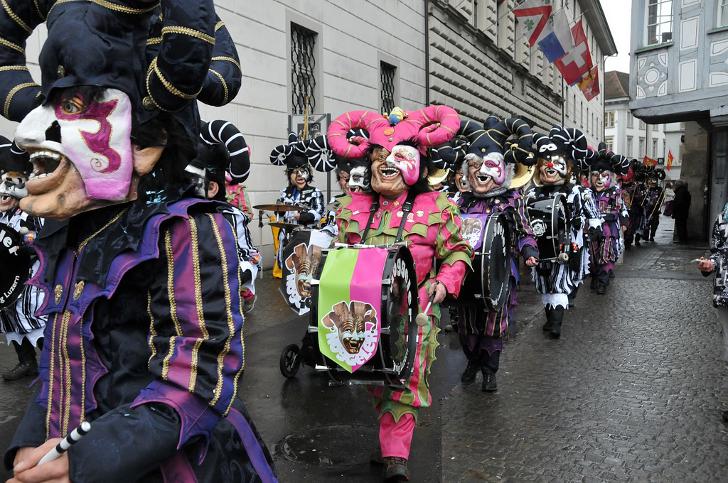The first day of the Lucerne Carnival is called Schmotziger Donnerstag. In standard German, this means “Dirty Thursday”, but the name is actually derived from Alemannic dialects spoken in all German-speaking parts of Switzerland where “schmotz” means “fat” or “lard”. So Schmotziger Donnerstag can be translated into English as Lardy Thursday.
The Lucerne Carnival opens with a big parade with colorful floats, costumed characters in papier-mâché masks, marching bands, dance troupes, and street performers. The opening parade is known as the Fritschi Parade, it takes place in Lucerne’s Old Town. The parade includes about 40 official groups and is often joined by unofficial participants. When the parade is over, the bands wander through the city streets, filling Lucerne with music and mingling with the crowd.
Carnival Friday, Saturday and Sunday are relatively calm. There are smaller parades, street parties, indoor balls, and private celebrations, but no big parades take place until Carnival Monday. The day known as Rose Monday (Rosenmontag) in Germany is called Paunch Monday (Güdismontag) in Lucerne. It features the Wey Parade with floats, groups of carnival musicians (Guggenmusiken), lights and lanterns. Even when the parade comes to an end, the musicians keep playing until midnight.
An even bigger parade known as the Monstercorso Parade takes place on Shrove Tuesday (Güdisdienstag), attracting thousands of spectators. The participants of the parade wear elaborate costumes and masks. The Monstercorso Parade is a nighttime event, it is preceded by the Children’s Parade held in the afternoon.
The central figure of the Lucerne Carnival is Fritschi, an elderly man accompanied by his wife Fritschene and their child Fritschkind. The origin and meaning of the figure are unclear, but the roots of Fritschi can be traced back to the 15th century. Fritchi and his family always participate in the opening parade.

Photo: Noggeler Guggenmusig Luzern




